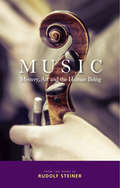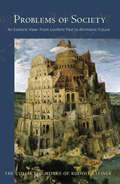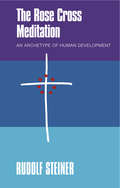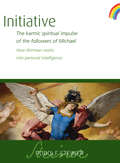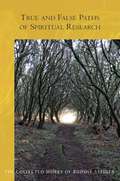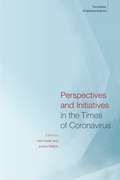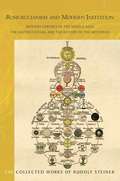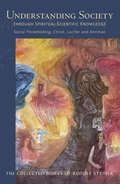- Table View
- List View
Music: Mystery, Art and the Human Being
by Rudolf Steiner'Our neurosensory system is inwardly configured music, and we experience music as an artistic quality to the degree that a piece of music is in tune with the mystery of our own musical structure.' - Rudolf SteinerWhat is music? Rudolf Steiner regards the essence of music as something spiritual, inaudible to the senses. The world of tones, borne on the vibrations of air, is not the essential element. 'The true nature of music, the spiritual element in music', he says, 'is found between the tones, lies in the intervals as an inaudible quality.'Rudolf Steiner spoke repeatedly about music as something inherent both in the cosmos and the human being. It played an important role in many forms of ritual and worship, and people once perceived a link between music and the world of stars, which was seen as the dwelling place of the gods. Nowadays our view of music is divorced from such religious outlooks, but research repeatedly demonstrates the profound effect it continues to have on us. In this unique anthology of texts, compiled with a commentary and notes by Michael Kurtz, Steiner describes the realm of the spiritually-resonating harmonies of the spheres and our intrinsic connection to this cosmic music. He also explores the phenomenon of musical listening and experience, as well as Goethe's approach to music.
The Human Spirit: Past and Present - Occult Fraternities and the Mystery of Golgotha (Lectures To The Workers)
by Rudolf Steiner‘To live in truth, to wish to be true in one’s whole being, will be the watchword of the future.’ – Rudolf Steiner. In the midst of the lies and propaganda of the Great War, Rudolf Steiner struggled to convey the truths of the human spirit. The ‘truth’ asserted by partisan interests, he suggested, was invariably tinged with dishonesty – whether the outright mendacities of politicians and rulers (Steiner refers here to the machinations of the British Empire), or the manipulative techniques of secret societies, intent on securing and shoring up their own power. In relation to the latter, Rudolf Steiner highlights how, whilst we tend to reject overt authority nowadays, we succumb more easily to its covert forms in the ‘received wisdoms’ we often unthinkingly adopt. In seeking to help his audiences discern the spiritual struggle unfolding behind outer events, Steiner describes how the intrigues that led to the war were based on intentional deceit, which served hidden aims of which the public was mostly kept in the dark. In contrast to the divisiveness of untruth, truth is based on a realization of the interconnectedness of all things – of interdependence between the realms ‘below’ and ‘above’ us. The ‘I’, upon which all evolution on earth is predicated, signifies an overcoming of egotism and narrow interests, together with the imaginative embrace of all beings. Its spiritual reality – that descends to us from non-material worlds and towards which we evolve through earthly lives – is the epitome of truth. Amidst many other topics covered here, Rudolf Steiner speaks about The Qur’an and the Mystery of Golgotha; Henry VIII, Thomas More and the Church of England; the Jesuits and their State in Paraguay; Freemasons, esoteric symbols, and handshakes; Madame Blavatsky’s occult imprisonment by Anglo-Saxon brotherhoods; Dostoyevsky’s The Brothers Karamazov; and the occult literature of Papus and Lévi.
Problems of Society: An Esoteric View, from Luciferic Past to Ahrimanic Future
by Rudolf Steiner‘Whatever turbulent outward events occur in the world, whatever form is taken by things seeking to work their way out of the depths of human evolution, we only really hearken to the true, underlying nature of these events ... if we observe the world from a spiritual perspective.’ – Rudolf Steiner. In seeking to heal the many social crises of our time, Rudolf Steiner urges us to turn away from ‘fixed principles, theories or social dogmas’ and to rediscover the real nature of the human being. This inner reality – that cannot be understood in materialistic or deterministic ways – is the only basis on which society can truly be founded. But it is not sufficient to speak of well-meaning ideas, he says, unless we are also active in working for change; change that begins with each of us. In 1919, a year marked by strong social and political upheavals, Steiner was deeply concerned with questions relating to society. Having published a book on the subject (Towards Social Renewal), he embarked on a major campaign to publicize his ‘threefold’ social ideas. In addition to public lectures, however, Steiner sought to deepen the subject in a series of talks to members of the Anthroposophical Society. These lectures, gathered in this volume, reveal the ‘inner’ or ‘esoteric’ aspects of the social question. They complement Steiner’s very practical efforts to realize threefolding in the historical context of his time. Whilst Steiner’s suggestions for social change may not seem self-evident to pragmatic thinking, they will strike a resonant chord in many who seek deeper answers to the social problems of our times – problems that politicians seem unable to remedy. Amidst the many themes tackled here, Steiner addresses the issue of nationalism as a retrograde tendency; the tasks of Central Europe and Britain in relation to the East; the incarnation of Ahriman in the West, and the historical incarnation of Lucifer in the third millennium BC.
Michael's Mission: Revealing the Essential Secrets of Human Nature
by Rudolf Steiner‘...This will generate a struggle covering the face of the whole earth. The one and only remedy for this nonsense being made of human evolution will be the path that can lead humanity to the spirit – the path of Michael, which finds its continuation in the path of Christ.’ – Rudolf Steiner. Speaking in the aftermath of the Great War, Rudolf Steiner presents a series of extraordinary lectures on the power and mission of the Archangel Michael. He paints on a broad canvas – in the context of cosmic and human evolution – revealing Michael’s tasks in the past, present and future. Originally the countenance of Yahweh, Michael has metamorphosed from a ‘night spirit’ to a ‘day spirit’. As ‘the Countenance of Christ’, Michael helps us find a balance between ‘luciferic’ and ‘ahrimanic’ tendencies. The old ‘dualism’ (such as good versus evil), says Steiner, needs to be replaced by the trinity of Lucifer-Christ-Ahriman. Filling our heart with the Christ Impulse creates an equilibrium between the luciferic influence that imbues our head and the ahrimanic influence at work in our limbs. Rudolf Steiner describes how humanity faces three dangers in the social sphere: spiritual life could flow into the ‘pit of mendacity’ ruled by Ahriman, individual rights might descend into the ‘pit of selfishness’ (Lucifer), and economics into cultural sickness and death (Asuras). In order to prevent European-American culture from perishing, it will be necessary to turn towards contemporary ‘threefold’ social ideas. Steiner also speaks about the principle of metamorphosis in connection with evolution and devolution, as evident in the design of the pillars in the newly-built Goetheanum. Architectural styles are an expression of human evolution, as can be seen in Greek temples, gothic Cathedrals, the Grail temple and the building at Dornach. Amidst many other themes, Rudolf Steiner addresses the problem of natural necessity and freedom, and the abolition of the trichotomy of body, soul and spirit at the Council of Constantinople in AD 869.
Eternal and Transient Elements in Human Life: The Cosmic Past of Humanity and the Mystery of Evil
by Rudolf SteinerIn what has been referred to as ‘the most advanced course in anthroposophy’, Rudolf Steiner addresses one of the great questions of our time: the role of evil in human development. He speaks of the year 666, when three time streams intersected – the familiar linear stream and two ‘lateral’ streams – and the reoccurrence of the 666-year rhythm in history. At the heart of this mystery is the being Sorat (‘the beast’), who attempted to flood humanity with premature spiritual knowledge by inspiring the scholars of the ancient Academy of Gondishapur. Although responsible for the saving of Aristotle’s works, Steiner describes how the Academy generated tremendous but dangerous gnostic wisdom, which eventually spread through the Christian monasteries and inspired Western scientific thought. Its immediate negative impact, however, had to be counteracted by the Prophet Muhammad and the founding of Islam. In contrast to the 666-year rhythm in history, the 333-year rhythm is connected to the healing forces of the Mystery of Golgotha. The year 333 was a central point in the post-Atlantean age, but also a pivotal moment in establishing the Christ Impulse and the new equilibrium it brought to humanity, allowing people to gain wisdom through their own efforts. Such wisdom enables insight into three key areas: supersensible knowledge of birth and death; understanding of an individual’s life; and the ability consciously to confront the adversarial beings of Lucifer and Ahriman. Steiner addresses a host of additional themes, including occult Freemasonry in Anglo-American countries; materialism in the Roman Catholic Church; prophetic and apocalyptic vision; dualism and fatalism in pre-Christian times; and the delusion of time and space. Seeking to awaken his listeners to the urgency of the tasks ahead of them, he urges that spiritual understanding be enlivened with enthusiasm, fire and warmth of heart.
The Rose Cross Meditation: An Archetype of Human Development
by Rudolf SteinerThe Rose Cross meditation is central to the western - Rosicrucian - path of personal development as presented by Rudolf Steiner. Steiner repeatedly referred to the meditation as a 'symbol of human development' that illustrates the transformation of the human being's instincts and desires. These work unconsciously in the soul, and in thought, feeling and will. Through personal development, the 'I' - the essential self - can gain mastery over these unconscious forces of the soul. The Rose Cross meditation features the red rose as an image to which the student, via specific means, aspires. To the plant is added the black cross which, pointing to the mystery of death and resurrection, provides a symbol of the higher development of the human I. The metamorphosis of the roses and the cross into the symbol of the Rose Cross is brought about by the student's inner efforts, creating an entirely new image. This becomes the starting point for further steps along the meditative path.The Rose Cross meditation is the only pictorial meditation whose content and structure Steiner described in such detail. In this invaluable book, the editor has drawn together virtually all Rudolf Steiner's statements on the subject, arranging them chronologically within the motif of each chapter. His words are supported by commentary and notes.
Imagination: Enhancing the Powers of Thinking
by Rudolf SteinerRudolf Steiner differentiated clearly between the spiritual concept of Imagination and our everyday understanding of the word. As living, pictorial thinking, Imagination is a primary aspect of the contemporary path of inner schooling – the first of three levels of initiate knowledge and cognition. Imagination leads us into a world of flowing, living pictures: a realm of soul and spirit in which everything is in continual movement.This anthology offers a survey of the diverse aspects of Imagination and imaginative cognition. As the thematically re-ordered texts reveal, Rudolf Steiner’s spiritual philosophy – anthroposophy – is itself often pictorial and imaginative in nature. Many of its fundamental concepts, such as the evolution of the world and the human being, were formulated by Steiner in vivid, living pictures. However, whilst imaginative perception leads us to the threshold of the spiritual world, we can also fall prey there to illusions, visions and hallucinations.This volume, expertly assembled by Edward de Boer, draws on the entirety of Rudolf Steiner’s collected works – from his earliest writings to passages from his many lectures. It is conceived as a stimulus to readers to practise, deepen and extend their own imaginative consciousness. Steiner’s commentary on ‘exemplary Imaginations’, in particular, encourages further study, contemplation and schooling of our own pictorial thinking.Chapters include ‘Imagination as Supersensible Cognition’; ‘The Rosicrucian Path of Schooling’; ‘Exercises to Develop Imagination’; ‘Understanding Imagination Through Inspiration and Intuition’; ‘Illusions, Hallucinations and Visions’; ‘Imaginative Perception as the Threshold to the Etheric World’; ‘Goethe’s Worldview’ and ‘Exemplary Imaginations’ (including commentary on ‘The Fairy-tale of the Green Snake and the Beautiful Lily’, The Mystery Plays; The Great Initiates; the ‘Apocalyptic Seals’; The Chymical Wedding of Christian Rosenkreutz and the ‘Michael Imagination’).
Intuition: The Focus of Thinking
by Rudolf SteinerRudolf Steiner draws a clear distinction between the spiritual meaning of the word Intuition and its ordinary definition. As the highest form of spiritual perception, Intuition has an existential significance for our process of knowledge. Through systematic schooling, thinking can be developed into an intuitive organ by means of which the spiritual can consciously be understood and penetrated. Intuition can reveal the essence of the spirit, the processes through which human beings and the world came into existence, and the events in our life after death. In his later works, Steiner spoke of Intuition as a form of supersensible knowledge that could provide direct insight into practical life, as exemplified here in his commentary on geometry, architecture, education, medicine, eurythmy, painting and the social organism.The concept of Intuition is fundamental to Rudolf Steiner’s spiritual philosophy. It denotes a clear, pure mode of comprehension akin to a mathematical concept. We meet it in his earliest writings on Goethe, in the development of his philosophical ideas and in his many lectures and addresses. Ably compiled and introduced by Edward de Boer, this volume clarifies a concept that evolved in Steiner’s thinking. By following the idea of Intuition in its gradual transformation and amplification throughout Steiner’s writing and lecturing career, the book offers not only inspiring paths to spiritual knowledge, but also insights into how anthroposophy developed.Chapters include: ‘The Perceptive Power of Judgement – Goethe’s Intuition’; ‘Moral Intuition – Experiencing Thinking’; ‘The Human Being – Intuition as a Bridge to the Spirit’; ‘The Schooling Path – Spiritual Development and the Power of Intuition’; ‘Intuition Exercises’; ‘Three Stages of Consciousness – Intuition in Relation to Imagination and Inspiration’; ‘Knowledge of Destiny – Intuition and Repeated Earth Lives’; ‘Intuition in Practice – Examples from Various Specialist Fields’.
Kundalini: Spiritual Perception and the Higher Element of Life
by Rudolf SteinerIn Hindu tradition, the concept of kundalini refers to a form of primal energy located at the base of the spine. Through traditional Eastern methods, efforts were made to ‘awaken’ the kundalini in order to achieve transformed consciousness. Rudolf Steiner offers an entirely new perspective, integrating the kundalini idea into his spiritual philosophy. This anthology contains all relevant comments and notes by Steiner on the theme, highlighting how his thinking evolved. At the same time, it accentuates the differences – and similarities – between Western and Eastern spiritual paths, and in the process reveals what is new and original about Steiner’s esoteric teachings.In contrast to most yoga traditions – which cultivate the energy rising from the lower life centre – the Western path of esoteric schooling starts in our upper centre of consciousness, in thinking and the ‘I’. From there, the centre of experience is shifted downward, from the head to the heart. After development of the ‘new heart centre’, as Rudolf Steiner describes it, forces can be guided consciously and, through specific exercises, the ‘kundalini snake’ can be fully awoken. In his detailed introduction, editor Andreas Meyer distils the perspectives and instructions from Steiner’s complete works, presenting a valuable synopsis for our understanding and practice of meditation today.Chapters include: ‘The Meaning of Meditation, and the Six Exercises’; ‘Developing and Cleansing the Lotus Flowers’; ‘The Snake Symbol’; ‘The Kundalini Fire’; ‘The Kundalini Light’; ‘Developing the New Heart Organ’; ‘The Reversal in Thinking and Will’; ‘Specific Aspects of Kundalini Schooling’; ‘Transforming Physical Love and the Division of the Sexes’; ‘Breathing, the Light-Soul Process, and the New Yoga Will’; ‘The Polarity of Light and Love’ and ‘Transforming the Kundalini Fire into Fraternity’.
Growing Old: The Spiritual Dimensions of Aging
by Rudolf Steiner‘And that is one thing we need to relearn, that all of life brings its gifts – not only the first two or three decades.’ – Rudolf SteinerWhen are we actually old? What happens as we age? How will we cope with old age? Growing old is an art, and to grow old in the right way we need spiritual understanding. In this enlightening anthology – compiled by a director of care homes for the elderly – wide-ranging cosmological perspectives alternate with detailed observations of the phenomena of ageing. Rudolf Steiner sees ageing within the context of the earthly and spiritual evolution that encompasses all forms of existence. The book thus begins with the primary meaning that ageing has in developmental terms and ends with a consideration of the human being as co-creator in cosmic processes – and with our capacity to become increasingly conscious of the tasks this implies.These key texts by Rudolf Steiner show how spiritual knowledge can broaden the current debate on the study of old age, the process of ageing, and the particular problems faced by older people. Concerns about our ‘ageing population’ can be seen in a broader context that recognizes the fruits of old age. The productive relationship between childhood and old age – a running theme throughout this volume – is one example. If we grow old consciously, viewing ageing not only as a period of physical decline but as a time when we can actively participate in shaping life, then we can begin to find greater meaning in it.Chapters include: ‘The Core Messages of Ageing’; ‘Fundamental Principles of Gerontology’; ‘Ageing as a Developmental Process’; ‘Ageing: the Risks and Opportunities’; The Art of Growing Old’; ‘Old Age and Death’; ‘Growing Old – A Challenge for Education’; ‘The Cosmological Dimensions of Ageing’.
Initiative: The karmic spiritual impulse of the followers of Michael. How Ahriman works into personal intelligence
by Rudolf Steiner‘Be a person of initiative, and take care that the hindrances of your own body, or hindrances that otherwise confront you, do not prevent you from finding the centre of your being, where the source of your initiative lies. Likewise, you will find that all joy and sorrow, all happiness and pain, depend on finding or not finding your own individual initiative. – Rudolf Steiner, Dornach, 4 August 1924Rudolf Steiner urges those who feel the calling of the Archangel Michael to become people of initiative. The anthroposophist should be aware that, ‘… initiative lies in his karma, and much of what meets him in this life will depend on the extent to which he can become willingly, actively conscious of it.’ In the second half of this inspiring lecture, Steiner describes how the being of Ahriman is able to work through the personal intellect of human beings today. As a consequence, we are called upon to be inwardly awake and vigilant at all times.
The Imaginative Life Tableau: The spiritually-percieved story of our life between birth and death. Meditative knowledge out of childhood forces.
by Rudolf SteinerMany will be familiar with the notion that a person at the point of death sees their life flash before them. Rudolf Steiner describes that when the spiritual bodies separate from the physical body, the etheric body of the dying person is revealed, giving a panoramic overview of their earthly life. This etheric body contains everything we have experienced in our consciousness and kept in memory. The etheric not only generates and sustains all life, but encompasses the life forces out of which we shape our existence. Although the revelation of the life tableau belongs to the early period after death, it can also emerge as a result of meditation. Rudolf Steiner speaks of this – through the first level of spiritual experience known as ‘imagination’ – as a conscious self-perception of the soul, taking place in the world of images. Here we are confronted with the harrowing knowledge of our doppelgänger – but we also experience the cosmic forces of childhood that are present in all our life processes. These same forces are described in psychology as the ‘inner child’. In this highly-original anthology of Steiner’s work we are led to a therapeutic, meditative approach that – through working with the imaginative life tableau – can strengthen and heal body, soul and spirit. Chapters include: ‘Experiencing the Inner Child as the Starting Point for a New Philosophy’; ‘Experiencing Life before Birth’; ‘Pain and Sadness When Reliving the Life Tableau’; ‘Intensive Backward Thinking’; ‘Feelings of Happiness When Experiencing the Life Tableau’; ‘Re-experiencing the Inner Child’; ‘Through the Forces of Childhood to the Higher Self and the Christ Experience’.
Memory: Remembering and Forgetting
by Rudolf SteinerWhat is the meaning of memory in the information age? When all knowledge is seemingly digitised and available for reference at any time, do we actually need human memory? One consequence of the proliferation of digitization is the deterioration of our capacity to remember – a symptom that is apparent in a steady increase in dementia within contemporary society. Rudolf Steiner indicates that memory is the determining factor in awareness of oneself. Even a partial loss of memory leads to loss of self-consciousness and the sense of our ‘I’. Thus, memory is crucial for the development of I-consciousness – not only for the individual, but for humanity as a whole. Rudolf Steiner’s research on memory, recollection and forgetting has many implications for the way we learn, for inner development and spiritual growth. This unique selection of passages from his works offers insights into how consciousness can remain autonomous and creative in a digital environment. It also provides ideas for improving education and emphasizes the importance of life-long learning. Chapters include: ‘The Development of Memory Throughout Human History’; ‘The Formation of Memory, Remembering and Forgetting in the Human Individual’; ‘Remembering and Forgetting in Connection with Education’; ‘How Remembering and Forgetting are Transformed by the Schooling Path – Imagination and Inspiration’; ‘Remembering Backwards (Rückschau) and Memory Exercises’; ‘Subconscious Memories of the Pre-birth Period and of Life Between Death and a New Birth’; ‘Memory and Remembering after Death’; ‘The Development of Memory in the Future’.
True and False Paths of Spiritual Research
by Rudolf SteinerIn these much-valued lectures, Rudolf Steiner begins by positing the question, ‘Why investigate the spiritual worlds at all?’ He goes on to explore the contemporary need for spiritual knowledge and the authentic paths that can lead to it. Speaking in Torquay, England, at the International Summer School organized by his friend and colleague D.N. Dunlop, Steiner surveys the differences in various types of consciousness – from ancient to modern times, in waking and dreaming, from space into time – and the changes that have taken place in relation to knowledge and science in the course of history. He goes on to discuss the Mystery nature of crystallized minerals and metals such as copper and silver, and their relationship to the planets. He also describes how the ages of life can become organs of perception. In a dramatic conclusion Steiner explains the role of moon beings, ahrimanic elemental beings, and the true nature of mediumship, ectoplasm and spiritual possession. Presented here in a fresh translation that corrects many errors in previous editions, the text is complemented with notes, an introduction by Paul King and an index. Lectures include: ‘Nature is the Great Illusion. “Know Thyself”’; ‘The Three Worlds and their Reflected Images’; ‘Form and Substantiality of the Mineral Kingdom in relation to Human Levels of Consciousness’; ‘The Secret of Research into other Realms through the Metamorphosis of Consciousness’; ‘The Inner Enlivening of the Soul through the Qualities of Metals’; ‘Initiation Science’; ‘Star Knowledge’; ‘Possible Aberrations in Spiritual Research’.
Perspectives and Initiatives in the Times of Coronavirus: The School of Spiritual Science
by Ueli Hurter and Justus WittichThe School of Spiritual Science, with its headquarters at the Goetheanum in Dornach, Switzerland, has eleven sections that are active worldwide in research, development, teaching and the practical implementation of research results. During the early stages of the Corona pandemic of 2020, the sections of the School made individual contributions to the crisis in the form of sixteen essays that offer insights, perspectives and approaches to tackling the challenges of Coronavirus through spiritual-scientific knowledge and practice.The work of each of the School’s sections seeks to develop anthroposophy – as founded by Rudolf Steiner (1861-1925) – in a contemporary context through the core disciplines of general anthroposophy, medicine, agriculture, pedagogy, natural science, mathematics and astronomy, literary and visual arts and humanities, performing arts and youth work.The featured essays include: Creating Spaces of Inner Freedom – Training Approaches in Times of Uncertainty and Fear; The Hidden Sun – Reality, Language and Artin Corona Times; Consequences of COVID-19 – Perspectives of Anthroposophic Medicine; Aspects of Epidemic Infectious Diseases in Rudolf Steiner’s Work; Challenges and Perspectives of the Corona Crisis in the Agricultural and Food Industry; Corona and Biodynamic Agriculture; Our Relationship with Animals; The Part and the Whole –On the Cognitive Approach of Anthroposophical Natural Science; Comparing the Constellations of the Corona Pandemic and the Spanish Flu; Aspects of Dealing with the Corona Crisis for Youth; ‘Crisis Implies that it’s Unclear…as to What,How, Why and by Whom Things Need to be Done’; Education in Times of Corona; Understanding History from the Future – Crisis as Opportunity; Social Challenges and Impulses of the COVID-19 Pandemic; Consequences of COVID-19 –The Perspective of Anthroposophic Curative Education, Social Pedagogy, Social Therapy and Inclusive Social Development; A Medicalized Society?
The AIMS OF ANTHROPOSOPHY: and the Purpose of the Goetheanum
by Rudolf SteinerIn his final lectures to the general public, Rudolf Steiner speaks with great clarity and purpose about the inner and outer necessity of the anthroposophical impulse in modern times. Following the fire that destroyed the first Goetheanum building in Dornach, Switzerland, Steiner had focused his efforts on rebuilding and reorganizing the Anthroposophical Society. But he also continued to travel and speak to the public – in Prague, Vienna and Basel – to explain the purpose of the Goetheanum and to elucidate the broader aims of his spiritual work. These lectures, including a semi-public series in Dornach, are gathered here and published in English for the first time, together with an introduction, notes and index.The volume features the following lectures: ‘The Purpose of the Goetheanum and the Aims of Anthroposophy’; ‘Enhancing Human Powers of Perception to Develop Imagination, Inspiration and Intuition’; ‘Human Soul Life and the Development of Imagination, Inspiration and Intuition’; ‘Experience and Perception of the Activities of Thinking and Speech’; ‘The Physical World and Moral-Spiritual Impulses’: ‘Four Stages of Inner Experience’; ‘Perceiving the Etheric World’; ‘Soul’s Eternity in the Light of Anthroposophy’; ‘Human Development and Education in the Light of Anthroposophy’; ‘Supersensible Perception, Anthroposophy as a Contemporary Need’; ‘Anthroposophy and the Ethical and Religious Life’; ‘How Do We Gain Knowledge of the Supersensible World?’
CONSCIOUS SOCIETY: Anthroposophy and the Social Question
by Rudolf SteinerDelivered in the context of post-war cultural and social chaos, these lectures form part of Rudolf Steiner’s energetic efforts to cultivate social understanding and renew culture through his innovative ideas based on ‘threefolding’. Steiner develops a subtle and discerning perception of how social dynamics could change and heal if they were founded on real insight into our threefold nature as individuals, social beings and economic participants in the world. He doesn’t offer a programmatic agenda for change, but a real foundation from which change can organically grow.Social forms and reforms, says Steiner, are ‘created together’, not imposed by lone geniuses. Nevertheless, the detail of some of the thoughts and ideas he presents here as a possible model – down to the economic specifics of commodity, labour, taxation, ground rent and capitalism itself – are staggering in their clarity and originality. This is no mystic effusion but a heartfelt plea, backed by profound insights, to change our thinking and the world we live in. As he points out, thoughts create reality, and so it is vital how and what we think.Among the many contemporary and highly-relevant topics Steiner discusses here are: the nature of money and capital; taxation and the state; free enterprise and initiative; capitalism and Marxism; the relationship between employer and employee; ‘added value’ theory and the concept of commodity; and ‘class consciousness’, the proletariat and the bourgeoisie.
FINDING INNER BALANCE: Meditative exercises for mindfulness, empathy and strengthening the will
by Klaus Adams Wolfgang Rissman M.D. Marko RoknicIn the midst of life we can find ourselves pulled in many different directions and it is easy to lose our sense of self. Is it possible to find and strengthen the inner core of who we are? Can we rediscover our inner equilibrium and tranquillity without retreating from the world?Since ancient times people have sought to re-establish inner balance by using specific meditative practices. The ‘soul exercises’ described in this booklet are derived from Rudolf Steiner’s spiritual philosophy, but also acknowledge the Buddhist tradition of mindfulness. Offering strategies to boost self-confidence, self-reliance, inner stability and concentration, they are intended for anyone seeking personal growth. The exercises are perfect for enriching everyday life, but can also help in times of stress, mental and emotional crisis, burn-out and in the context of psychiatric and psychosomatic therapies.In a series of short chapters illustrated with beautiful colour photos, this booklet offers accessible and easy-to-follow commentary and instructions on creating a path of inner development and balance.
FOUNDATIONS OF ESOTERICISM
by Rudolf Steiner‘It is a cosmic law that what has once taken place can never vanish, but must reappear later in a metamorphosed form. Every thought, feeling and action brought about by man does not only affect the world around him but will re-appear in the future…’ (From the Preface)This course of lectures was originally offered as private, strictly verbal instruction to a select group of esoteric pupils. In an atmosphere of earnest study, Rudolf Steiner ‘translated’ from the Akashic Script valuable concepts of human and cosmic knowledge into words of earthly language – content that is often not to be found in his later lectures. Although working within the Theosophical Society, Steiner was an independent spiritual teacher: ‘… I would only bring forward the results of what I beheld in my own spiritual research.’The manifold, exact and detailed descriptions of the events of evolution in these lectures form a background to the evolving figure of the human being. The mighty event of the moon leaving the Earth, vividly described, took place – according to Rudolf Steiner – in order to provide an environment suited to human progress. The wonderful moment when the higher being of man descended in a bell-like form and enveloped the lower human body, still on a level with the animals, depicts what eventually provided human beings with a body suited to the development of the self or ‘I’. Spiritual beings and the great initiates led humanity along the path it was destined to tread.Rudolf Steiner presents a sweep of occult knowledge, including the phases of planetary evolution, various myths and symbols, human physical and spiritual organs, illness, reincarnation, and much more. Also included are unexpected insights into specific phenomena such as dinosaurs, bacteria, radiation, black and white magic, the Sphinx and Freemasonry.
INITIATION SCIENCE: and the Development of the Human Mind
by Rudolf SteinerIn an astonishing series of lectures on the science of spiritual knowledge, Rudolf Steiner begins by addressing an audience in Dornach, Switzerland – where, only months earlier, his architectural masterpiece, the first Goetheanum, had been destroyed by fire. He discusses the nature of our planetary system, revealing the planets that are characterised by freedom and those that determine destiny. The spirits of the moon live in seclusion, preserving ‘original wisdom’ and reflecting powers connected to sexuality, whereas the sun creates harmony. Jupiter is ‘the thinker’, whilst the spirits on Saturn act as ‘living memory’. Speaking in London, Steiner states that the things that happen to people in sleep are more important than anything that occurs during waking hours! Human beings, he says, must learn to see themselves as an image of spirits and spiritual activities on earth.In a break from the theme, and returning to Dornach, Rudolf Steiner reports on his recent visit to England and Wales, where he attended an educational conference in Ilkley, a Summer School in Penmaenmawr and a school for the disadvantaged in the East End of London. Steiner speaks of the particular atmosphere he experienced in West Yorkshire and North Wales, where remnants of Druid spirituality live in the surroundings. The latter theme emerges strongly in the next lectures, which examine the Druid priest’s sun initiation and perception of moon spirits. The Druids investigated the secrets of the universe, influencing both social and religious life. Steiner also describes the mythic being of Woden, who signified the birth of intellectuality and the subsequent fear of death – which, he asserts, can be healed by the Mystery of Golgotha.In the final section, Rudolf Steiner discusses: ‘The past, present and future development of the human mind’. Again, he references the importance of Druid culture, noting that the ground plans of the stone circles in Penmaenmawr are similar to that of the first Goetheanum. He also points to the crucial roles of the ancient Mysteries and Christ’s deed in human development.
LIFE OF THE HUMAN SOUL: and its Relation to World Evolution
by Rudolf SteinerHow are we connected to the world around us? This question, says Rudolf Steiner, is one that lives subliminally, drawing us into the depths of the psyche. There, our candle of consciousness tends to flicker and go out. But spiritual schooling can relight it, so that we learn to perceive realms of our being beyond the restricted self.Whilst Steiner was undertaking major lecture tours of Germany and England, he took time to address his followers at the world centre of anthroposophy in Dornach, Switzerland. He speaks here on three major topics: ‘The Life of the Human Soul’, ‘Spiritual Striving in Relation to Earth’s Evolution’ and ‘The Contrast Between East and West’. The common theme, however, is our mutual responsibility for what the human being and the world will eventually become – which, according to Steiner, is far from a foregone conclusion. Even the way we think can change and affect the future: the degree, for example, to which we concentrate our picturing in meditation, infusing head thinking with warmth of heart.Rudolf Steiner reveals a hugely complex picture of interrelationships between humanity and the cosmos. Our head, heart, lungs and limbs all reveal subtly different qualities of connection with the invisible realities that continue to sustain us. Our eyes, for instance, only gradually evolved into organs of sight and were once vital organs, as our lungs are now. The lungs, in turn, will similarly evolve to provide us with another form of perception.As is usually the case, Steiner addresses a wide variety of topics in addition to those above. Included in this volume are thoughts on the significance of the cinema; the nature of the halo; technology as the ‘true foundation’ of the modern worldview; asceticism in the Middle Ages; the world of machines and the world of rite and worship; yoga and modern meditation exercises; pain as an awakener of knowledge; the emergence of the belief in ghosts; and the connection between stomach acid and soul qualities.
OUR CONNECTION WITH THE ELEMENTAL WORLD: Kalevala – Olaf Åsteson – The Russian People. The World as the Result of Balancing Influences
by Rudolf SteinerThe heart of this volume comprises Rudolf Steiner’s commentary on the elemental forces that are responsible for our earthly nature as human beings – forces that influence us through our membership of a national or geographical group. When such elemental forces are not recognised and understood, he states, they cause conflict and chaos. However, Steiner indicates an important accompanying task that calls upon each human being to develop individuality, emancipating ourselves from the earthly influences underlying national and racial groups.These great themes are framed by Rudolf Steiner’s pioneering research into the two major Northern folk-poems, the Kalevala and The Dream Song of Olaf Åsteson. The former tells of the elemental spirits who created the conditions for our earthly incarnation, whereas the Dream Song has to do with the drama of excarnation – the journey of the human soul after death. Linking these vast motifs is Steiner’s unique description of the mission and tasks of the Russian people and the contrast of their destiny to the North American people (who, he says, are ‘dominating the Earth for a brief period of increasing splendour’).Steiner explains how elemental beings, responsible for the balance of land and sea, have created conditions where various peoples are enabled to develop their gifts and fulfil their destinies. Thus he speaks of Finland as the ancient conscience of Europe, Russia as the future bearer of the Christ-imbued Spirit Self, and the differing but complementary environments of Germany and Britain. Strikingly, he states that, ‘no souls on Earth love one another more than those living in Central Europe and those living in the British Isles’.Rudolf Steiner also speaks of the necessary work of luciferic and ahrimanic beings that collaborate to enable the solid spatial forms of our physical bodies. Likewise, they influence our etheric and astral bodies, facilitating thinking, feeling and will to be imbued with life and consciousness.
ROSICRUCIANISM AND MODERN INITIATION: Mystery Centres of the Middle Ages. The Easter Festival and the History of the Mysteries
by Rudolf Steiner‘Steiner has been able to clarify the historical reality behind the Rosicrucian story, with all its aura of glamour and fantasy. That effected, he points to the enormity of its vision for the future evolution of ideas…’ – Dr Andrew Welburn (from the Introduction)In the immediate aftermath of the ‘Mystery-act’ of the Christmas Foundation Conference, Rudolf Steiner chose to speak on the subject of ‘Rosicrucianism and Modern Initiation, Mystery Centres of the Middle Ages’. Clearly connected to the events that had just taken place in Dornach – in which he not only refounded the Anthroposophical Society but took a formal position within it – Steiner begins by exploring the intellectual life of the Middle Ages and the role that Mystery culture played within it. He throws new light on the foundations of Rosicrucianism, its principles of initiation and its inherent impulse for freedom. Steiner also discusses the secret teachings of the eighteenth and nineteenth centuries, and the dawn of the age of the Archangel Michael.In the second series of lectures, entitled ‘The Easter Festival and the History of the Mysteries’ (April 1924), Steiner describes how festivals grew out of the Mysteries themselves. He speaks of Mysteries connected to Spring and Autumn, Adonis and Ephesus, and the significance of Sun and Moon. Throughout the volume he discusses the roles of Alexander the Great and Aristotle in world history and the significance of Aristotle’s ‘Categories’. Published for the first time as a single volume, the freshly revised text is complemented with an extensive introduction by Dr Andrew Welburn, detailed notes and appendices by Professor Frederick Amrine and an index.
SOCIAL THREEFOLDING: Rebalancing Culture, Politics & Economics. An Introductory Reader
by Rudolf SteinerIn the aftermath of the devastating First World War, Rudolf Steiner gained a reputation as a leading social thinker. One mainstream reviewer of his book Towards Social Renewal referred to it as ‘… perhaps the most widely read of all books on politics appearing since the war’. Steiner’s proposals for the reconstruction of Europe and the rebuilding of society’s crumbling social structure were thus publicly discussed as a serious alternative to both Communism and Capitalism.Steiner’s ‘threefold’ ideas involved the progressive independence of society’s economic, political and cultural institutions. This would be realised through the promotion of human rights and equality in political life, freedom in the cultural realm and associative cooperation in economics or business.In this carefully assembled anthology of Steiner’s lectures and writing, Stephen E. Usher gathers key concepts and insights to form a coherent picture of social threefolding. Apart from fundamental lectures on the theme, the volume also features the full content of Steiner’s unique Memoranda of 1917. The original texts are complemented with the Editor’s introduction, commentary and notes.
UNDERSTANDING SOCIETY: Through Spiritual-Scientific Knowledge. Social Threefolding, Christ, Lucifer and Ahriman
by Rudolf SteinerIn the uncertainty following the end of the First World War, Rudolf Steiner perceived a unique opportunity to establish a healthy social and political constitution. He began lecturing throughout post-war Germany, often to large audiences, about his social ideas. Here, speaking to a more intimate grouping at the Goetheanum in Dornach, Switzerland, Steiner seeks to deepen the themes of social threefolding, showing specifically how new social thinking is integral to anthroposophy.Steiner speaks of the superficiality of the materialistic view of history, originating with the economic shift amongst the population at the time of the Reformation. Back in Egyptian-Chaldean times, initiates ruled out of spiritual impulses. Later, in the Greco-Roman period, priests had power over their congregations. Today, homo economicus – or ‘economic man’ – has become the dominant idea, with the capitalist and the banker taking control. But the healing of social relationships can only come about through different modes of thought; the life of spirit must be separated not only from politics but also from economics. True social understanding allows for comprehension of karma – the appreciation of each person’s individual destiny. In parallel, says Steiner, we should work towards a global consciousness, as true social ideas are founded on people feeling themselves to be citizens of the world.In an important corollary, Steiner studies the incarnations of three significant spiritual beings in human evolution: Lucifer, Christ and Ahriman. Lucifer incarnated in the third pre-Christian millennium, Christ incarnated at the dawn of a new age, whilst an incarnation of Ahriman in the West is immanent. Ahriman is preparing this incarnation by insidiously promoting various ideas, for example that economic security is sufficient for healthy public life. A new wisdom must be achieved out of free human will, says Steiner, or else we will succumb to Ahriman.
